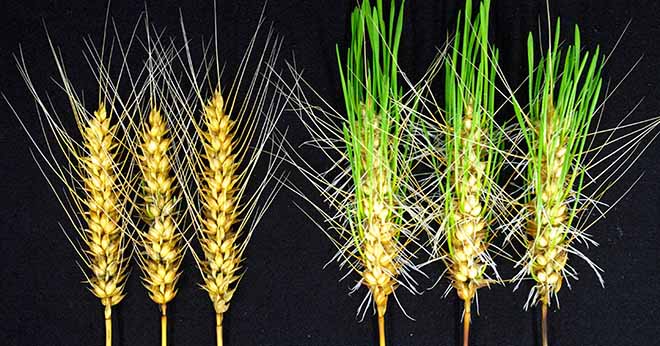 It is a sobering statistic that since 2001, we have lost more than 850 agrochemicals, 50 of which have been in the past eight years through regulatory processes.
It is a sobering statistic that since 2001, we have lost more than 850 agrochemicals, 50 of which have been in the past eight years through regulatory processes.
The loss of some big names such as chlorothalonil, the neonicotinoids, methiocarb, diquat and chlorpropham (CIPC) was unthinkable five years ago. Stalwarts of the fungicide armoury – epoxiconazole, tebuconazole and metconazole – will be disappearing from the shelves very soon too.
So is it all doom and gloom? Absolutely not.
The recent launch in Sept of the UK’s first BYDV resistant wheat was a real breakthrough, as well as one of the industry’s best kept secrets. At the launch, it was revealed that the first attempts to develop such a wheat have been going on for 20 years.
Modern-day breeding methods have undoubtedly accelerated the whole process, the most recent of which is the John Innes Centres speed-breeding capability. Fully enclosed controlled-environment growth chambers with specially configured LED lighting in a glasshouse environment allow rapid generation cycling through single seed descent resulting in accelerated plant development
Speed breeding can be used to achieve up to six generations per year for spring wheat, durum wheat, barley, and peas, four generations for oilseed rape.
This is the start of what can only be described as an exciting future whereby speed breeding can be integrated with other new crop-breeding technologies such as high-throughput genotyping, genome editing, and genomic selection.
What is also encouraging is that in addition to the Defra-funded Wheat Genetic Improvement Network (WGIN), there are many other global initiatives in wheat breeding where the results and genetic material are made available to breeders worldwide. There is the G20 wheat initiative, International Wheat Yield Partnership (IWYP), French public research institute INRA, ProWeizen, Triticeae Coordinated Agricultural Project (TCAP), Cimmyt/Icarda, and the Gates Foundation.
But it isn’t just in wheat breeding where genetics are taking a major step forward. The first resistant sugar beet to beet virus yellows could be available within three years. A collaborative breeding programme has been taking place since 2014 between SESVanderHave, MariboHilleshog and BBRO. Innovate UK helped to fund the project. There are three viruses that cause beet yellows, so it has been quite a task to get the genetic resistance in place to avoid the infection. This could be a really significant step forward in helping the viability of the crop without neonicotinoid seed treatments.
OSR is another crop soon to be benefiting from advances in breeding. The original DEFRA funding through OREGIN (Oilseed Rape Genetic Improvement Network) was key in identifying varieties carrying valuable traits. A number of current research projects have spun out of this early work from the original set of 101 varieties.
There are early indications that some varieties from the panel are less palatable to cabbage stem flea beetle and slugs. Field observations have been backed up by more accurate controlled-environment studies with both pests.
The reason why the pests are not attracted to these lines isn’t clearly understood. But it would appear that slugs have a taste preference and CSFB adults have a smell preference. In one slug trial, they preferred to eat the agar in the Petri dish rather than the plant cotyledons.
Turnip yellows (TuYV) resistant OSR is another major step forward; it’s no coincidence to see varieties such as Architect and Temptation with this trait performing well in AHDB Recommended List trials due to the background level of this viral disease. Post neonicotinoid seed treatments, the number of peach potato aphids which are the vectors of the virus will only increase.
Other traits that have been identified in OREGIN are a consistent, enhanced germination and vigour, phoma resistance, light leaf spot, verticillium wilt, N,P,K and S use efficiency,

Japanese scientists have used gene-editing technology to develop a rain-resistant wheat variety, simply by targeting and switching off Qsd1, a gene associated with sprouting also found in barley where it doesn’t function properly.
There is also activity to improve the quality and type of oil that OSR produces which will enhance the market value of the crop.
Rapeseed oil contains fat-soluble compounds with health benefits, including phytosterols (which reduce the absorption of unhealthy cholesterol), vitamin K, and vitamin E, important for protection against oxidative stress, atherosclerosis, cardiovascular diseases, cataracts and neural tube defects. The OREGIN variety collection provides natural variation of all these characteristics which can be exploited.
Finally, the most important technology our scientists need access to in order to speed up delivery of many of these and future traits is CRISPR-Cas9, or gene editing. Murmurings from Michael Gove when he was Secretary of State for Defra, gave indications that post Brexit, this could be a possibility. In the meantime, advancements using mutagenesis breeding whether using mutation chemicals or gamma radiation are the only options for adding novel variation outside natural variation.
Formerly technical director at Velcourt, Keith Norman is an independent consultant who avidly pursues innovation in agriculture. @KeithNorman_Ag




